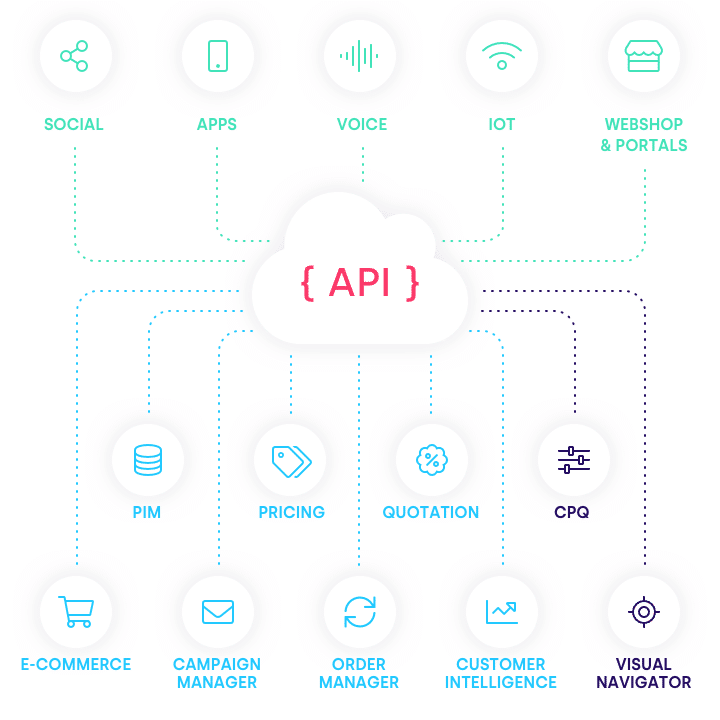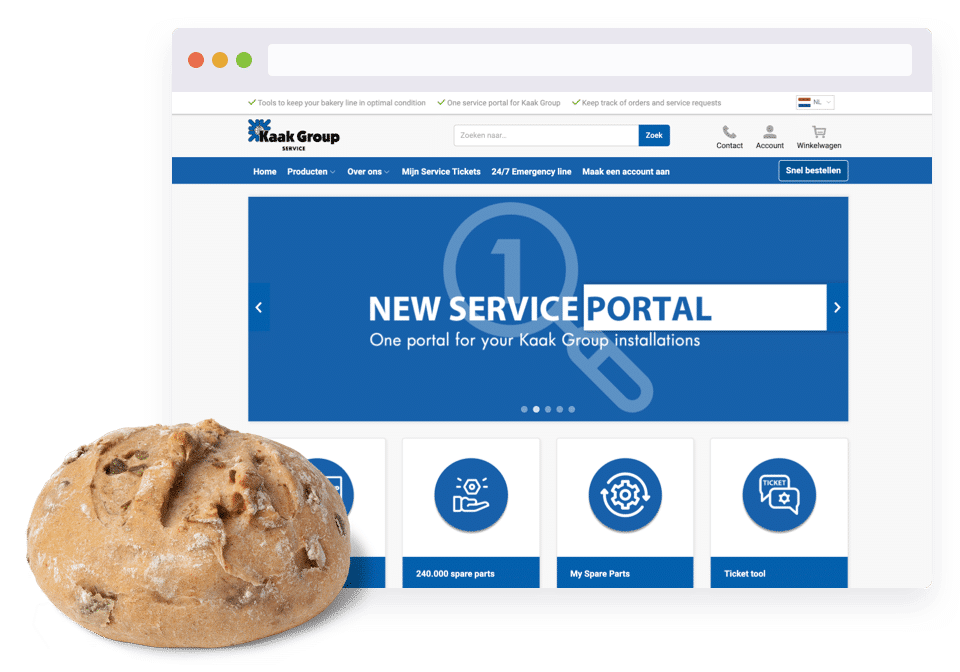E-commerce is increasingly becoming the main sales channel for many B2B businesses, above all in the spare parts industry, but this is also true in the case of wholesalers, business suppliers, and managed service suppliers. Hardly surprising, because e-commerce is efficient, clearly structured, and effective.
You have probably come across this article because you have been working for some time now as an e-commerce manager in an organization with an online sales platform that sells parts for, to pick one example, industrial machines in the agriculture sector. Or maybe you are the product owner of a customer portal for a company that sells vehicles in the transport sector.
The thing that you have in common, is that you would like to raise the webshop to a higher level. It is possible that not all your systems are linked to your customer portal. In other words: the sales activities are not yet structured in accordance with the principle of working with one single platform, and with a clear online architecture. And that is the very thing that can take your e-commerce activities to the next level.
The ideal situation is a design based on one platform, which all the other systems are connected to. By linking all the systems with the commerce platforms, you achieve a major step forward in efficiency within your organization. Think in terms of ERP, RMA, ticket systems, but also integration with your suppliers.
For the sake of clarity: the one platform approach does not mean by definition that only one system is running. The aim is that in the end, you will finally have a comprehensive digital ecosystem that offers all the customers their own user experience. This means that multiple systems in the back-end are linked, in order to attain that ambition level.
But how do you know whether your business and online platform are ready to think and to be organized on the basis of one single platform? How do you know whether you are ready for one-platform e-commerce, with a customer portal that offers the ultimate user experience?
These 5 questions will help you to evaluate whether you are ready for one-platform e-commerce.
Answer the following 5 questions. Take the time to carefully appraise the existing situation. Afterward, we will help you to discover the best solution for your organization.
Question 1: Are the offline sales processes already connected to online sales?
What frequently occurs in companies, is that the e-commerce platform, so the customer portal, is used for smaller or ongoing orders. These are mostly the orders that are repeated, such as parts that the customer has been using for a long time. Many companies have account managers who handle complex orders.
Account managers ask for the price internally from the procurement division and then draw up a quotation. Often this all takes place either via an in-house CRM system or an Excel spreadsheet.
Is this the case in your company as well? Are the orders via the account manager not linked to the online sales? If the answer is ‘yes’, then read on. If the answer is no, but you are still looking for a better user experience and more online sales possibilities via the customer portal, then skip to question 5.
Question 2: How often is a tailored quotation passed backward and forwards between the account manager and customer?
As stated above, the wholesale webshop, or the customer portal, is mostly used by customers for their repeat orders. Many companies have account managers who handle complex orders. The account manager receives the request for the order via email or telephone and then asks for a price internally from the procurement division. The purchaser requests a price (or checks it) with the wholesaler or distributor. The purchaser then sends a price via an Excel spreadsheet or direct in the mail. The account manager then draws up the quotation in an in-house system or in another Excel spreadsheet. This then goes to the customer.
So, before the customer receives the quotation, there has already been a lot of emailing back and forth between an account manager and the purchaser. Besides this, it is quite possible that a fault has crept in somewhere, the customer wants something else after all, or the quotation isn’t entirely complete. In that case, the account manager, having already sent the first quotation, has to request another price internally in order to draw up a revised quotation.
Does this seem familiar? Would you like to know how this process can run more smoothly? If the answer is yes, then we will come back to this point shortly. But first, we would like to know a bit more about the offline sales process in your organization.
Question 3: How much time does the account manager actually spend on quotations?
We just described the process of emailing and making phone calls back and forth. And that was only internal, between the sales and procurement divisions. But the account manager also spends a lot of time identifying the wishes of the customer, answering the customer’s questions, and sending out a correct quotation.
Does this process take 5-8 days in your organization? This time could be spent more productively and efficiently.
Question 4: How often does an upsell take place?
If the account manager spends a lot of time making a quotation for parts that are not available via the customer portal, how is the account manager going to find any time for proactively sharing ideas with the customer? How often are upsells made within your organization, as a result of a request for a quotation? Is that number less than four to six times per month?
Then there are certainly more opportunities. Because a good account manager doesn’t just share ideas with customers but also succeeds in exploiting opportunities for an upsell. But if the processes described above take too long, then it is hardly surprising if sales opportunities are being missed. And that is when working with linked systems offers such clear added value.
If everything works on the basis of one platform; the customer can input their request directly in the customer portal. The account manager has access to all the purchasing and sales prices he needs to draw up a quotation in the same platform. The customer can then inspect this in the portal, ask questions or directly accept the quotation. This saves time throughout the whole process and makes it easy to follow. It also enables the account manager to suggest an upsell.
Consider the following situation. The customer orders a number of large parts for his plant’s furnace; a monthly service or comprehensive installation might be a good upsell possibility here.

Question 5: If you look at the existing system, such as your ERP and PIM, what works and what doesn’t work?
Take a good look at the existing ERP system; it often forms the backbone of a B2B organization. A lot of time and money will have been invested in it in the past. It is logical that, as an organization, you don’t want to throw all of that investment away. But have you been noticing that it no longer works as well and as efficiently as desired?
Do the problems seem to be piling up? Then it is time to consider a new online infrastructure. Because in most cases systems are not linked. This means that a lot of work still has to be done manually, which is time-consuming and inefficient.
Due to growth in turnover in B2B e-commerce, a PIM (Product Information Management system) is becoming increasingly important. If your PIM is an integral part of the e-commerce platform, you can easily integrate this with your ERP system. And if you purchase from multiple distributors with overlapping products, you will certainly need to standardize. This takes place with a PIM. The goal has to be to achieve an end-to-end system. This not only cuts out a lot of human interventions but also prevents errors as a result.
In the platform from Propeller, the PIM is an integral part of the software. The PIM from Propeller collects product information, including prices, out of the client’s ERP. You can then enrich the product content, either automatically or otherwise. You can also create a wide variety of product combinations in the PIM, such as 3-for-2 offers or, for example, a laptop with a bag.
This means that your ERP is the backbone for your product info, but our PIM does smart things with it. If you try to do those smart things within the ERP, on the one hand, the performance will suffer badly, and on the other hand, you will have to start tinkering about in your ERP, which is simply too expensive and time-consuming.
Ready to get connected, and to shift to a higher gear with e-commerce?
As a B2B business, you have a customer portal, a must-have for a successful B2B e-commerce organization. But it is time to expand this now; the customer portal needs to be at the heart of the whole sales organization. By linking all your systems to this you reduce the pressure on the internal organization and it can take over part of the sales support function. The customer portal needs to be the communication channel with your customers, where customers can place orders, arrange and organize things for themselves.
The customer portal can be linked to the systems of suppliers and distributors. So, when a customer orders something in the e-commerce environment this order can be purchased from a particular supplier without manual intervention. Furthermore, if desired the software from Propeller automatically selects the supplier with the best purchase conditions for the order and weighs this up against the speed of delivery.
As a result, the number of errors reduces significantly and time is saved on the part of both the purchasing party and the supplier, the margin is always optimized, and the end-customer is quickly sent the right product. Naturally, this convenience will ultimately pay for itself, because the customer will deliver a lot of repeat business and the situation can be described as vendor lock-in. That is the next level in your e-commerce business and the ultimate goal.
Hear what another satisfied client has to say.
Still not fully convinced about how one platform can benefit your organization? At Propeller, we know all too well that it is better for us to allow our satisfied clients to have their say.
According to Marcus van Es, e-commerce manager with Kaak FPS, the Propeller platform was the right match because 95% of their wishes were already within the standard package of the platform. Besides this, Propeller’s extensive experience with complex processes appealed to Van Es’s imagination. Because the e-commerce issue that Kaak FPS had was certainly complex. Kaak FPS needed a customer portal that offered their customers in the bakery industry insight into their own line and parts. In addition, it had to be integrated with met 4 ERP systems.

Furthermore, they wanted the agreed prices per customer to be integrated into the customer portal and they needed a software integration with four different ERP packages in a multilingual back-end and front-end. Kaak’s customers can now filter for country, factory, production line, and machine, and in this way order precisely the right part. As a result, they never order the wrong product anymore. Besides this, each customer only sees the prices that have been agreed with them.
Propeller managed to get this up and running within 4 months. This not only enabled Kaak to increase customer satisfaction, but also to expand the number of customers. Furthermore, a significantly larger group of customers order their spare parts online now, which has drastically reduced the pressure on inside sales. In addition, frequently asked questions are answered in Kaak’s service portal.
To make the online adaptation even greater, Propeller’s software has also integrated the ticket system in the portal, so that customers only have to use one entry point for all their questions, products, and issues. An ideal environment for cross and upselling.
Reach the ultimate goal
The ultimate goal in the field of e-commerce is when, like an e-commerce business, you can organize and offer as much as possible via the customer portal, so that customers can come to you for all their needs. By linking the sales channels and ensuring that account managers can spend their time more efficiently, you can increase turnover. Besides this, you can achieve greater operating efficiency if the systems are coordinated together.
The customer portal needs to be an online one-stop-shop, with everything matched – it needs to be a one-stop-shop for the customers in your sector. This means that the digital architecture has to be rock-solid, with all relevant systems linked. Building the ultimate customer portal does call for investment. But this will certainly pay for itself because the portal will ultimately reduce the workload of both sales personnel and the account managers.
In addition, you can also anticipate further ROI in the form of a significant saving in FTE’s (less administrative work) and higher turnover due to increased sales activities on the part of account managers and more upsell opportunities. This last factor can certainly deliver approximately 3% more turnover. So, based on your organization’s current turnover and the number of inside sales and sales representatives, we can calculate an impressive business case.
Furthermore, working with one central online architecture offers an even better customer experience every time, with an up-to-date product list. Easily attaining the next level, that sounds like the ultimate goal, doesn’t it?
Contact us to talk about how we can make your organization ready for the next phase in e-commerce. We look forward to helping you with all your questions, and to sharing ideas with you to make the complex simpler. Besides this, we can certainly help you put together the business case to convince the stakeholders.





